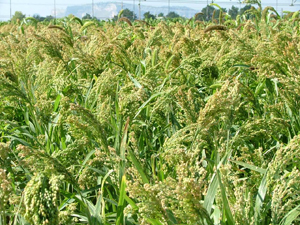G1945
Fertilizing Proso Millet
Soil testing and crop rotation are the basis for fertilization of proso millet.
Dipak K. Santra, Alternative Crops Specialist
- Soil Testing
- Nitrogen (N) Recommendations
- Phosphorus (P) Recommendations
- Potassium (K) Recommendations
- Other Nutrients
- Acknowledgment
|
Soil Testing
Soil testing is the foundation of proper nutrient management for optimum production of proso millet. The goal of soil testing is to characterize the amount of nutrients in the soil prior to planting. Fertilizer management that provides adequate but not excessive plant nutrients is essential for high yield of proso millet in the High Plains (Figure 1).
Soil samples from the surface (0 to 8 inches depth) should be analyzed for organic matter, pH, phosphorus, potassium, and nitrate-nitrogen. A subsoil sample from 30 to 36 inches depth should be taken for nitrate-nitrogen only. Refer to the NebGuide Guidelines for Soil Sampling (G1740), available online at www.ianrpubs.unl.edu/sendIt/g1740.pdf for more information.
Soil testing for nitrate-nitrogen before planting each proso millet crop is recommended. Other soil tests for other nutrients are recommended every three to four years.
Nitrogen (N) Recommendations
Proso millet is generally grown under dryland conditions, either in continuous cropping or after summer fallow. Nitrogen fertilizer is often required for profitable production. Proso millet planted following another crop, such as wheat, has a higher nitrogen requirement than after summer fallow. Suggested nitrogen fertilizer rates for proso millet are shown in Table I.
| Table I. Nitrogen recommendations for proso millet with a 3-foot soil sampling depth. | |||
Soil Test |
Previous Crop |
||
Nitrate-N |
Fallow |
Wheat |
|
lbs NO3-N/acre |
ppm NO3-N |
lb N/acre to apply |
lbs N/acre to apply |
0-20 |
0-1.9 |
55 |
75 |
21-35 |
1.9-3.2 |
35 |
55 |
36-50 |
3.2-4.6 |
20 |
35 |
51-65 |
4.6-6.0 |
10 |
20 |
66-80 |
6.0-7.4 |
0 |
10 |
>80 |
>7.4 |
0 |
0 |
All nitrogen fertilizer sources are generally effective. Urea-based fertilizers are commonly used (urea and urea-ammonium nitrate solutions) and should be incorporated to avoid nitrogen volatilization (gaseous loss as ammonia). When nitrogen fertilizers are placed with the seed at planting, no more than 20 pounds of nitrogen per acre should be applied to avoid germination damage. Higher rates of nitrogen can be applied safely when placed at least 2 inches away from the seed. Anhydrous ammonia can be used but is not a typical source due to soil disruption, knife spacing, and soil drying that might affect stand.
Phosphorus (P) Recommendations
In the western High Plains, proso millet is commonly grown on high pH or calcareous soils. The Olsen-P soil test is recommended for high pH soil, whereas the Bray P-1 soil test is suggested for neutral to acidic soil. The Mehlich 3 soil test is used by many commercial laboratories because it works well across acidic to calcareous soils.
Phosphorus fertilizer application method affects plant response to phosphorus. Banded phosphorus fertilizer with the seed has been more effective than broadcasting phosphorus.
Phosphorus recommendations are given in Table II.
| Table II. Phosphorus recommendations for proso millet. | ||||
Soil Test Value — ppm |
Banded lb P2O5/acre to apply |
Broadcast lb
P2O5/acre to apply |
||
Bray P-1 |
Mehlich 3 |
Olsen - P |
||
< 10 |
<12 |
< 6.7 |
30 |
60 |
10-15 |
12-18 |
6.7 -10 |
20 |
40 |
15-20 |
18-25 |
10 - 13.3 |
10 |
20 |
> 20 |
>25 |
> 13.3 |
0 |
0 |
Potassium (K) Recommendations
Adequate potassium nutrition is essential; however, most High Plains soils contain sufficient potassium for maximum proso millet production. Table III shows potassium needed for low potassium soils.
| Table III. Potassium recommendations for proso millet. | |
Soil Test Level ppm K |
Broadcast lbs K2O/acre to apply |
0-39 |
120 |
40-74 |
80 |
75-124 |
40 |
>125 |
0 |
Other Nutrients
Proso millet rarely shows increases from sulfur or micronutrients. Zinc deficiency can be determined by soil testing. When the DPTA-Zn test is less than 0.5 ppm, zinc application is recommended. One-half to 1 pound of zinc with 10-34-0 (seed-applied) is usually sufficient to prevent deficiency.
Acknowledgment
Thanks to Frank Anderson and Juan Rodriguez who provided much of the original research and to David D. Baltensperger and Jüerg M. Blumenthal for earlier versions of this NebGuide.
This publication has been peer reviewed.
Visit the University of Nebraska–Lincoln Extension Publications Web site for more publications.
Index: Crop Production/Field Crops
Miscellaneous Crops
Issued May 2009
